An Aztec Folio
Text 7: The Murders of
Coatlicue and Coyolxauhqui
Reading Group Format
Table of Contents
Introduction and Explanations
Source
The following text is from Bernardino de Sahagún's Historia General de las Cosas de Nueva España, rendered into English by Arthur J.O. Anderson and Charles E. Dibble (Santa Fe, NM 1952, Monographs of the School of American research No. 14, published by the Santa Fe: School of American research and University of Utah). This passage comes from Sahagún's Book 3: "The Origin of the Gods" and constitutes Part IV of the monograph, pp. 1-5.
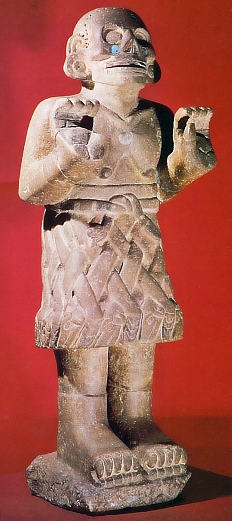
Coatlicue ("Snake Skirt"), from Coxcatlan. One of the avatars of the widely worshipped Mother Goddess, patroness of the earth, Coatlicue was considered (or at least declared) to be the mother of the Aztec patron god Huitzilopochtli.
(National Museum of Anthropology, Mexico City)This On-Line Version
In this reading, Sahagún's original, XVIth-century Nahuatl spellings (based on XVIth-century Spanish spellings) have been retained to show how Classical Nahuatl actually looks. For example, you will notice the use of V and J to represent U and I. Or the use of V/U for HU. Or the use of the sign ~ over a vowel instead of writing the letter N after it, a common Spanish abbreviation of the period. You will also notice a rather casual interchange between U and O in some vowel combinations —remember that Nahuatl has no vowel corresponding to U. Similarly Ç seems to alternate freely with Z. (You may also notice that Sahagún, like his much younger contemporary Shakespeare and like many college students, is quite inconsistent in his spelling and uses far fewer capital letters than we do today.)
The result can look quite exotic to someone used only to modern spellings:
- Jn Vitzilopuchtli, in cena qujmaviztiliaia in Mexica.
(In Huitzilopochtli in cena quimahuiztiliayah in Mexicah.)
To Huitzilopochtli the Mexicans paid great honor.
- ioan in itech muchioaia in Vitzilobuchtli.
(Ihuan in itech mochihuaya in Huitzilopochtli.)
And Huitzilopochtli rewarded him [who did so].
- ie ixqujch.
(Ye ixquich.)
Enough [of this].
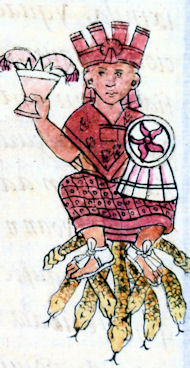
Coatlicue ("Snake Skirt"), from the
Florentine Codex.
I have very slightly modified the translation to make the spelling of Nahuatl words in the English text correspond to modern usage rather than to Sahagún's spelling (although I have not marked long vowels). I have also tried to break the text as much as possible into very brief, numbered parts to facilitate referring to them, and have inserted my own "chapter titles" to help you find your place again if you do not read it all at one sitting.
The Story
This story is one of the most important in all of Aztec mythology, for it tells of the virgin birth of the Aztec god Huitzilopochtli, and of what he did to those who tried to prevent it.
The story is set at a place called Coatepec, or the "Hill of the Snakes" located, we are told, near Tula (Nahuatl: Tollan). It has been persuasively argued that the great pyramid dedicated to Huitzilopochtli at the Templo Mayor in the heart of the Aztec capital of Tenochtitlan was intended to represent that hill (among other things), and the famous sculpture of the dismembered Coyolxauhqui located at the foot of the stairway would seem to confirm this. (That sculpture forms the background design on this page.)
Dramatis Personae
- Coatlicue [= Serpent Skirt < cōā-tl + cuē-I-tl]
- A pious goddess doing penances at Coatepec [Hill of the Snakes < cōā-tl + tepe-tl + c] near Tollan (Tula)
- Centzon Huitznahua [= Four Hundred Rabbits < cën-tli + tzon-tli + huitznahuatl]
- Her rather gullible children, who seem to have been rabbits at the time, and are now stars
- Coyolxauhqui [= Bell ? < coyol-li + ?]
- Coatlicue's evil daughter, younger sister of the Rabbits (with bells on her face)
- Cuahuitlicac [= Tree Standing < cuahui-tl + icac]
- One of the Rabbits, a traitor to their cause
- Huitzilopochtli [= Hummingbird's Left Side < huitzilin + opoch-copa]
- Coatlicue's son, god of the sun, and patron of the Aztecs, a ferocious warrior
Return to top.
Chapter 1: Coatlicue Encounters an Infelicitous Feather
|
1. Jn Vitzilopuchtli, in cena qujmaviztiliaia in Mexica.
|
To Huitzilopochtli the Mexicans paid great honor.
|
|
2. Yvin in qujmatia, in itzintiliz, in ipeoaliz,
|
The following they believed of his beginning, his origin.
|
|
3. ca in coatepec, yvjcpa in tullan, cemilhujtl quitztica, vmpa nenca cihoatl, itoca Coatlicue: innan centzonuitznaoa. auh inveltiuh, itoca, Coiolxauh.
|
At Coatepec, near Tollan, there always had dwelt and lived a woman named Coatlicue, mother of the Centzon Huitznahua. And their elder sister was named Coyolxauhqui.
|
|
4. auh in iehoatl coatlicue, vncan tlamaceoaia, tlachpanaia, quimocuitlaviaia, in tlachpanalli.
|
And this Coatlicue performed penances there; she swept; she was charged with the sweeping.
|
|
5. Jnjc tlamaceoaia, in coatepec.
|
Thus did she do penance at Coatepetl.
|
|
6. auh ceppa in iquac tlachpanaia, in coatlicue ipan oaltemoc ihujtl,
|
And once, as she swept, feathers, as it were, a ball of feathers, descended upon her.
|
|
7. iuhqujn ihujtelolotli, njman concujtiuetz in Coatlicue:
|
Then Coatlicue snatched it up and placed it in her bosom.
|
|
8. ixillan contlali, auh in ontlachpan njman cõcuizquja yn ivitl, in ixillan oqujtlalica aoc tle qujttac,
|
And when she had swept, [when] she came to take the feather [ball] which she had placed in her bosom, she found nothing.
|
|
9. njman ic otztic in Coatlicue.
|
Thereupon Coatlicue conceived.
|
Return to top.
Chapter 2: Coyolxauhqui Incites Her 400 Rabbit Brothers
|
10. auh in oqujttaque in centzonvitznaoa in jnnan ie otztli, cenca qualanque qujtoque
|
And when the Centzon Huitznahua saw that their mother was already with child, they were very wrathful. They said:
|
|
11. ac oq'chivili y aqujn ocotzti? techavilq'xtia, techpinauhtia.
|
"Who brought this about? Who hath made her heavy with child? She hath dishonored and shamed us!"
|
|
12. auh in jnveltiuh in Coiolxauh: quimjlvi noqujchtioan techavilqujxtia çan ticmjctia in tonan, in tlaueliloc in ie otztli: ca oqujchivili in itic ca.
|
And their elder sister, Coyolxauhqui, said to them: "My elder brothers, she hath affronted us; we must slay our mother, the wicked one who is already with child. Who is the cause of what is in her womb?"
|
[This text does not say how Coatlicue learns of Coyolxauhqui's wrath, but other sources suggest that one of the Rabbits revealed the plan to her. A prime candidate would be Cuahuitlicac, as we shall see. Huitzilopochtli, the child of the feather, overhears the report from within her womb.]
|
13. auh in oqujma Coatlicue: cenca momauhti, cenca motequjpacho.
|
And when Coatlicue learned of this, she was sorely afraid and deeply saddened.
|
|
14. auh in jconeuh in jtic catca qujiollaliaia, quioalnotzaia quilhujaia, maca ximomauhti ie ne njcmati,
|
And her child, who was in her womb, comforted her. He spoke and said to her: "Have no fear; already I know [what I shall do]."
|
|
15. in oqujcac in Coatlicue, in itlatol in jconeuh, cenca ic moiollali, motlali yn jiollo, iuhquin juhcan tlama.
|
When Coatlicue heard the words of her son, she was much consoled by them and her heart was eased of what had so terrified her.
|
|
16. auh in ie iuhq', in centzonvitznaoa in oqujcẽtlalique in jntlatol, in oqujcemjtoq̃iça qujmictizque in jnnan, iehica ca otlapinauhti, ça çenca muchicaoaia, cenca qualanja,
|
And upon this, when the Centzon Huitznahua had assembled for their deliberations, when they had made up their minds that indeed they would slay their mother because verily she had brought dishonor, much did they harden themselves; they were exceeding wroth.
|
|
17. iuhquj in qujçaia in jiollo, in Coiolxauhquj, cenca qujnioleoaia, qujniollococoltiaia in joqujchtioa, in macuele miquj in jnnan.
|
As if bursting her heart, Coyolxauhqui greatly incited and aroused the anger of her elder brothers, that they might slay their mother.
|
|
18. auh in cẽtzonvitznaoa, njman ie ic mocẽcaoa, moiaochichioa.
|
And the Centzon Huitznahua thereupon arrayed and prepared themselves for war.
|
|
19. auh in iehoantin centzonvitznaoa, iuhq'n tequjoaque catca tlacujaia, tlaquauicujaia, quiquauicujaia in jntzon, in jnquatzon.
|
And these Centzon Huitznahua were like seasoned warriors. They wound and twisted [their hair]; they bound their hair about their heads [in warrior array].
|
|
20. auh ce itoca Quavitlicac, necoc qujtlalitinenca in itlatol, in tlein qujtooaia centzonvitznaoa, njman conilhujaia, connonotzaia in Vitzilobuchtli.
|
And [there was] one named Cuahuitlicac, who was a traitor; that which the Centzonuitnaua said, he then told and brought as news to Huitzilopochtli.
|
Content Challenge 20: Cuahuitlicac's conversations with the still unborn Huitzilopochtli seem not to have aroused the interest of Coatlicue. In fact, we hear no more in this text of Huitzilopochtli's mother. In art she is represented with her head and arms cut off, and blood (in the form of huge snakes) shooting out, and we may therefore assume that Huitzilopochtli was not born in time to prevent Coyolxauhqui from hacking her up. Considering this myth as a whole and the dialog with Cuahuitlicac in the passage below, do you think Huitzilopochtli deliberately waited for his mother's death before emerging? Why or why not?
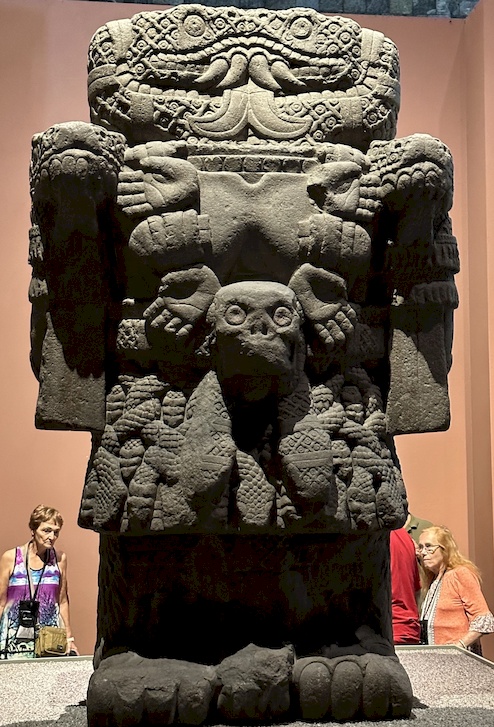
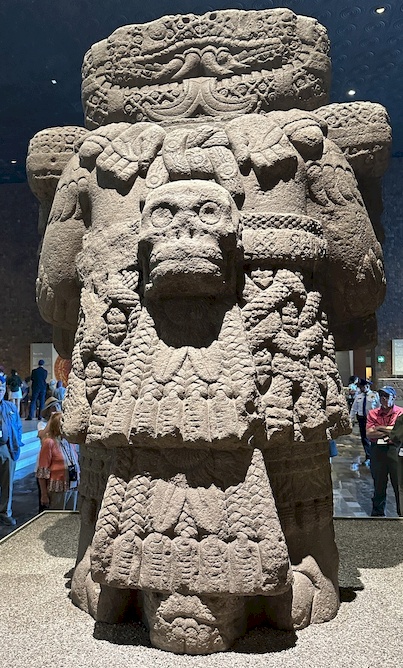
Coatlicue, Shown From the Front (Left) and Back.
The statue here —one of the relatively few representations of Coatlicue— shows her skirt of snakes and her necklace of human hearts and hands, as well as the blood spurting from her neck and shoulders. In this sculpture the blood is transformed into two snakes, which circle back so that their heads come together to produce the appearance of a single face on each side, grinning both on the front and on the back of the figure. With the eldritch effect of two snake heads simultaneously being one, added to the meticulous carving, it is one of the masterworks of Aztec stone sculpture, but, at nine feet high, it is also one of the most intimidating (although the tourists in the picture seem to be taking it in stride). It stands in the Museo Nacional de Antropología, in Mexico City.
|
Return to top.
Chapter 3: Huitzilopochtli Lies in Wait
|
21. auh in vitzilobuchtli: quioalilhujaia in Quavitlicac: cenca tleticmomachitia notlatzine, vel xonmotlacaqujlti ic ne njcmati.
|
And Huitzilopochtli said to Cuahuitlicac: "Watch well what they do, my dear uncle, and pay careful heed; for already I know [what I shall do]."
|
|
22. auh in ie iuhquj in iequene oqujcemjtoque, in ocentetix in jntlatol, injc quimjctizque, injc quitlatlatizque in jnnan,
|
And finally, when [the Centzon Huitznahua] were determined and of one mind in their deliberations that they would put to death and dispose of their mother,
|
|
23. njman ie ic vi teiacana in Coiolxauhquj,
|
they thereupon set forth. Coyolxauhqui led them.
|
|
24. vel muchichicaoa, mocecenquetza, moiaochichiuhque, motlamamacaque, intech quitlalique in jmamatlatquj, in anecuiotl, intzitzicaz, amatitech pipilcac, tlacujlolli, yoan in coiolli incotztitech qujilpique,
|
Much did they exert and drive themselves. They were in war array, which was distributed [among them] ; all put in place their paper array, the paper crowns,? their nettles," painted paper streamers, and they bound bells to the calves of their legs.
|
|
25. injn coiolli mjtoaia oiovalli, yoan in jnmiuh tlatzontectli,
|
These bells were called oyoalli. And their darts [had] barbed points.
|
|
26. niman ie ic vi, tetecpantivi, tlatlamantitivi, tlaieiecotivj, momamátivi, teiacana in Coiolxauhquj.
|
Thereupon they set forth; they went in order, in columns, in armed display, moving with deliberation. Coyolxauhqui led them.
|
|
27. auh in Quavitlicac, njman ie ic motlalotitleco, in qujnonotzaz in Vitzilobuchtli quilhuj ca ie vitze,
|
And Cuahuitlicac thereupon hastened to run up [the hill], that he might warn Huitzilopochtli. He said: "Already they are coming."
|
|
28. njman qujto in Vitzilobuchtli, vel xontlachie can ie vitze
|
Then Huitzilopochtli spoke: "Watch well where they come."
|
|
29. njman ie ic conilhuja in Quavitlicac: ca ie tzonpantitlan,
|
Thereupon Cuahuitlicac said to him: "Already they are at Tzompantitlan."
|
|
30. ie no ceppa quioalilhuja in Vitzilobuchtli, cã ie vitze,
|
Again Huitzilopochtli addressed him: "Where now do they come?"
|
|
31. njman conilhui ca ie coaxalpan vitze,
|
Then [Cuahuitlicac] said to him: "Already they are at Coaxalpan."
|
|
32. ie no ceppa quioalilhuj in Vitzilobuchtli in Quavitlicac: tla xontlachie can ie vitze,
|
Once more Huitzilopochtli called out to Cuahuitlicac: 'see where they now come."
|
|
33. njman ic conilhui ca ie apetlac,
|
Then [this one] said to him: "Already they are at Apetlac."
|
|
34. ie no ceppa quioalilhui, can ie vitze,
|
Once again [Huitzilopochtli] spoke forth to him: "Where now do they come?"
|
|
35. njman conilhuj in Quavitlicac: ca ie tlatlacapan iativitze.
|
Then Cuahuitlicac answered him: "Already they have come half way up the slope of the mountain."
|
[Translators Anderson and Dibble add a note at this point (p. 3 n. 9) pointing out that these place names seem, in the story, to be locations in the surrounding countryside, but by Aztec times they were names of parts of the Templo Mayor. (Tzompantitlan, for example, would refer to the tzompantli, a rack where the heads of sacrificial victims were displayed.) This further strengthens the link between the pyramid of Huitzilopochtli at the Templo Mayor and this myth, but it is unclear whether the places in the myth are named after temple parts or the temple parts are named after real, but still unidentified, geographical locations near Tula.]
|
36. Auh in vitzilobuchtli: ie no ceppa quioalilhuj, in Quavitlicac. quilhuj tla xontlachia can ie vitze.
|
And Huitzilopochtli again spoke forth to Cuahuitlicac; he said: "Watch where they now come."
|
|
37. njman jc conilhuj in Quavitlicac, ca iequene oalpanvetzi, iequene oalaci teiacantivitz in Coiolxauhquj.
|
Then Cuahuitlicac said unto him: "At last they are coming up here; at last they reach here. Coyolxauhqui cometh ahead of them."
|
|
38. Auh in Vitzilobuchtli: njman jc oallacat,
|
And Huitzilopochtli then burst forth, born.
|
[Huitzilopochtli appears to have been born filthy but fully armed, particularly with his shield and his trusty blue atlatl, both of which appear, like King Arthur's sword Excalibur, to have been known to generations after by proper names: Tehuehuelli (?) and Xiuh-ahtlatl (Turquoise Atlatl).]
Return to top.
Chapter 4: The Evil Coyolxauhqui Meets Her Fate
|
39. njman itlatquj oalietia in ichimal, tevevelli, yoan in jmiuh, yoan yiatlauh xoxoctic, mjtoa xioatlatl,
|
Then his array he brought forth with him —his shield [named] Tehuehuelli, and his darts, and his dart thrower, all blue, named Xiuhahtlatl.
|
|
40. yoan icxitlan tlatlaan, ic ommichiuh yn iconecujtl, mjtoaia ipilnechioal,
|
And in diagonal stripes was his face painted, with his child's offal, called his child's painting.
|
|
41. moquapotonj, ixquac, yoan inanacaztlan,
|
He was pasted with feathers about his forehead and about his ears.
|
|
42. auh ce pitzaoac in jcxi yiopochcopa, qujpotonj in jxocpal, yoan qujtexooaoan in jmetz vmexti. yoan vmexti in jacol.
|
And on his one thin foot, his left, he had the sole pasted with feathers, and he had stained both of his thighs with blue mineral earth, and both upper arms.
|
[With Huitzilopochtli now both born and armed, the battle begins. He has the advantage of surprise, and the battle doesn't take very long. Scholars disagree about the next sentence. The "serpent xiuhcoatl" may be a bladed weapon.]
|
43. auh ce itoca Tochancalquj contlati in xjuhcoatl, quioalnaoati in Vitzilobuchtli:
|
And one named Tochancalqui laid fire to the serpent xiuhcoatl at the command of Huitzilopochtli.
|
|
44. njman jc quixil in Coiolxauhquj : auh njman quechcotontivetz, in itzontecon vmpa ommocauh in jtenpa coatepetl.
|
Then with it he pierced Coyolxauhqui, and then he quickly struck off her head. It came to rest there on the slope of [Mt.] Coatepetl.
|
|
45. auh in itlac tlatzintlan vetzico tetextitivetz, cececcan veuetz in jma, in jcxi, yoan itlac.
|
And her body went falling below; it went crashing in pieces; in various places her arms, her legs, and her body kept falling.
|
|
[Coyolxauhqui's severed head on the left is carved from a huge block of green stone, about 80 cm (over 2½ feet) high. The bas relief on the right, 3.3 meters (nearly 11 feet) in diameter, shows the dismembered body of Coyolxauhqui, It was placed flat (image skyward) at the foot of Huitzilopochtli's pyramid, the Coatepec, in the Templo Mayor. It is not clear whether we are intended to understand that Huitzilopochtli hacked Coyolxauhqui to bits, or whether we are to believe that, without her head, she simply fell apart.]
|
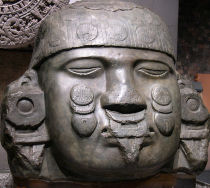
Colyolxauhqui's Head (Identifiable by the Bells on Her Cheeks)
Museo Nacional de Antropología |
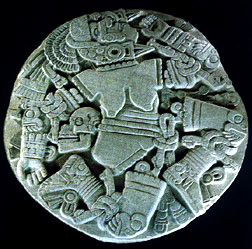
Coyolxauhqui's Dismembered Body
Museo Nacional de Antropología |
Return to top.
Chapter 5: The Rabbits Beg in Vain for Mercy
|
46. auh in Vitzilobuchtli: njman ie oaleoa, qujnoaltoca intlan aquj, qujnoaltemovia, q'noaltepeoa in centzonvitznaoa, in Coatepetl icpac.
|
And Huitzilopochtli then arose and pursued the Centzon Huitznahua, and went among them, and pounced upon them, and scattered them from the top of [Mt.] Coatepetl.
|
|
47. auh in oqujmaxitico in tlalchi, in tlatzintlan, niman ie ic qujntoca, qujniaiaoalochti in Coatepetl, nappa in q'ntlatlaiaoalochti, in qujniaiaoalochti,
|
And when he had pursued them to the base, the foot [of the mountain], he took after them and gave them chase around the skirts [=base? DKJ] of Coatepetl.
|
|
48. oc nen quioaloiuhtivia oc nẽ quioaloioviaia, oalmochimalvitectiuia, aoc tle vel quichiuhque, aoc tle vel axque, aocmo vel quitzacuilique,
|
Four times he pursued and followed them around. In vain they went about doing what they might against him; in vain they stood against him, striking about with their shields. No more could they do, no more could they achieve; neither could they take refuge.
|
|
49. çan qujncemeviti in Vitzilobuchtli: qujncentepotzti, vel qujnpopolo, vel quimixtlati, vel qujnpoctlantili.
|
Huitzilopochtli quite overpowered them; he made them turn tail; he destroyed them in battle. He completely bested and ill-used them.
|
|
50. auh in ça aocmo vel qujncaoaia, in ovel in centech mopilo, cenca quitlatlauhtiaia, quilhujaia ma ixquich.
|
And not even now did he let them alone. He kept on. Much did they [then] importune him. They said to him: "Let this be enough!"
|
|
51. auh in Vitzilobuchtli: amo ic moiolcevi,
|
But Huitzilopochtli would not content himself with this.
|
|
52. ca cena intech motlapalo in qujntocac.
|
With force he hurled himself against them and took after them.
|
|
53. auh ça quezquitoton in ixpanpa eoaque, in imacpa quizque vmpa itztiaque in vitztlanpa, iehica ca vmpa itztiaque,
|
And only very few fled his presence and escaped his hands. They went toward a haven to the south.
|
|
54. inin centzonviçnaoa, in oquizqujntin in imatitlanpa quizque in Vitzilobuchtli:
|
For indeed to that place these Centzon Huitznahua journeyed —the few who escaped the hands of Huitzilopochtli.
|
|
Content Challenge 54: As used here, it is not clear whether "vitzlanpa" (= Huitzlampa) in line 53 is a generic term (here translated "haven") or the name of a particular place. Google Huitzlampa. What do you learn about it? In view of that, how should we interpret the above passage. |
|
Chapter 6: Huitzilopochtli Reigns Triumphant Over All
|
55. auh in ie iuhquj in oqujnmjcti, in oyiellelquiz qujncuili in jntlatquj, in jnnechichioal in anecuiotl,
|
And when he had slain them, when he had spent his wrath, he took from them their vestments, their adornment, their paper crowns ornamented with feathers.
|
|
56. qujmotlatquiti, qujmaxcati, qujmotonalti, iuhq'n qujmotlavizti.
|
He arrayed himself with these and took [them] for himself; he assumed [them] as his due, as if taking the insignia to himself.
|
|
57. auh in Vitzilobuchtli: no mjtoaia tetzavitl, iehica ca çan jvitl, in temoc injc otztic in jnan in coacue: caiac nez in ita.
|
And Huitzilopochtli was also known as an omen of evil; because from only a feather which fell, his mother Coatlicue conceived. For no one came forth as his father.
|
|
58. Jehoatl in oqujpiaia in mexica injc otlamanitiaia, inic oqujmaviztiliaia, oquitlaecoltiaia,
|
This one the Mexicans cherished, by making offerings to him, and by honoring and serving him.
|
|
59. ioan in itech muchioaia in Vitzilobuchtli.
|
And Huitzilopochtli rewarded him [who did so]."
|
|
60. auh in iehoatl in tlamaviztililiztli ocatca, ca vmpa tlaãtli in Coatepec, in juh muchivi ca ie uecauh
|
And this veneration was taken from there, at Coatepec, just as had been done in days of yore.
|
|
61. ie ixqujch.
|
Enough [of this].
|
Proceed to:
0. Introduction,
1. Quetzalcöätl,
2. Toltecs,
3. Market,
4. Flaying,
5. Lord of the Dead,
6. Poems,
7. Murder,
8. Guadalupe
Return to top.
Background Design: Coyolxauhqui Sacrificial Stone, Templo Mayor, Mexico City





